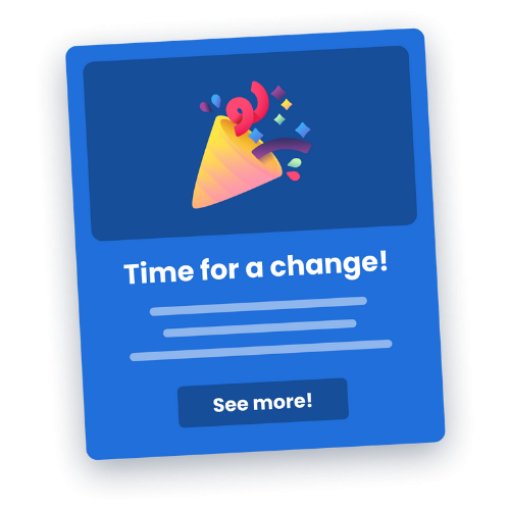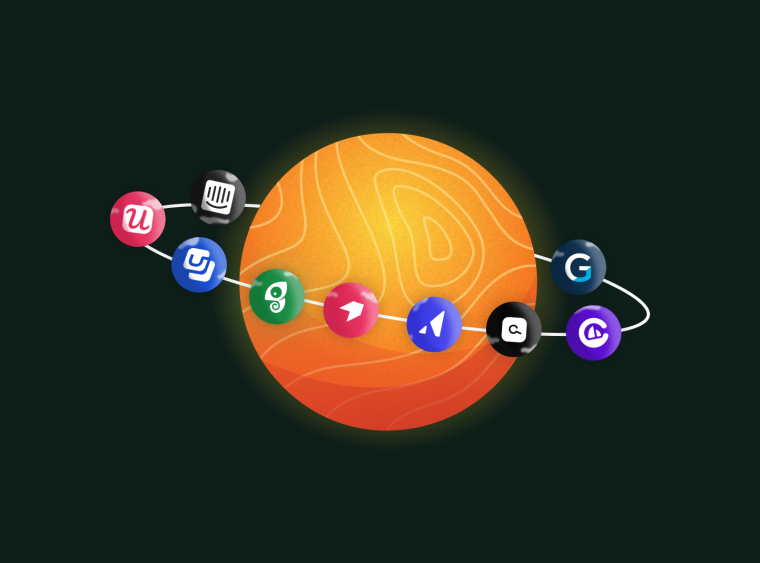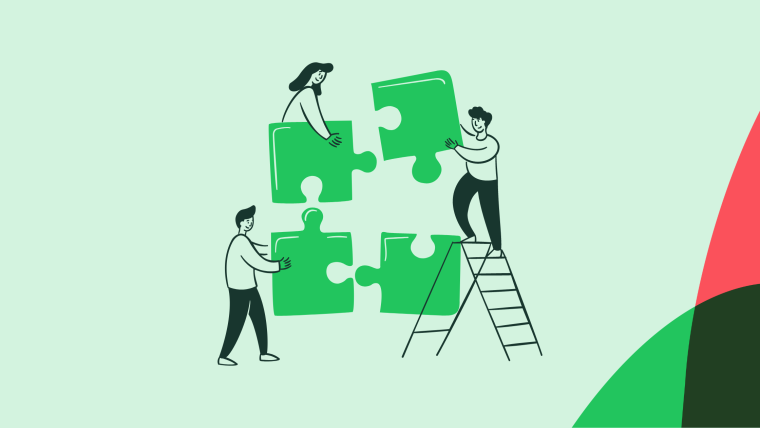Getting more users to sign up for your product is one thing, but nudging them to commit to it is a totally different ballgame. This transition from an unaware rookie user to a satisfied power user is what we call the product adoption process.
Put simply, product adoption is how you help your users love your product.
In this article, we'll fill you in on the different product adoption stages with actionable insights on creating a strategy for each step of the product adoption pipeline. We'll end with four proven tactics to increase your product adoption rate for new and existing users. We'll also provide a few examples of metrics with which you can measure product adoption.
Product adoption measures how successfully users can incorporate your product within their workflows and routines
Users adopt a product over six stages of product adoption: awareness, interest, evaluation, trial, activation, and adoption
The awareness stage is about meeting users where they are to improve product discovery
The interest stage is for generating more attention for your product to get more sign-ups
The evaluation stage is about convincing interested users to test-drive your product
The trial stage is where users sign up to check out your product’s functionality and utility
The activation stage is when users experience your product’s true value and become power users
The adoption stage is when you reach the peak of user engagement and win their loyalty
To succeed at product adoption, you need a frictionless and personalized onboarding experience, contextual user feedback, seamless self-serve support, and you need to engage users consistently.
What are the stages of product adoption?
Product adoption is the process of helping new and existing users to understand your product and how they can use it to best meet their needs. Successful product adoption is about ensuring your users can see the value of your product for their day-to-day tasks.
Users unaware of your product go through six stages of product adoption to reach their aha! moment. Despite these different product adoption stages, it's rarely a linear process.
For example, users can instantly reach their activation point once they discover the app or drop off after the trial stage but reach activation after a long gap. It depends on each individual user journey—but it’s key to know the stages your users pass through.
Adoption stages vs. Adoption curve: Is there a difference?
The stages of the product adoption process are often used interchangeably with the customer segments that make up the product adoption curve, but there is a difference, so let's just briefly go through what is different before we proceed with each of the adoption stages.
Customer segments like Innovators, Early Adopters, Early Majority, Late Majority, and Laggards are typically connected to a product adoption curve. This refers to how people adopt new technology and it's often related to completely new products on the market. Here, the adoption process goes from a few people using it to a lot of people (or the majority of people) using it.
A good example of this is social networks. When Facebook launched for the first time, for example, there were Innovators who started using it immediately, and, as the product evolved, more and more people joined—all the way through to Laggards who started using it "only because everyone else is".
This is what the product adoption curve typically looks like.

On the other hand, with a SaaS product that's been on the market for some time, customers and users go through several stages before they adopt it (or reject it). These stages involve Awareness, Interest, Evaluation, Trial, Activation, and Adoption, and that's what makes users progress from "preview users" to "power users".
If we apply BJ Fogg's Behavioral Model to software, keeping in mind that there should be motivation, ability, and prompts for prospective customers and existing users to progress through the stages, this is what the diagram would look like.

Now that we’ve explained the difference, let’s break down each of the product adoption stages and go through a few best practices for each to win over your users at every stage.
6 stages of the product adoption process
In an ideal world, product adoption would be a two-step process where users sign up to your product and become loyal customers. However, in reality, an average user goes through six stages to fully adopt a product and get the best out of it.
If that wasn’t enough struggle, here’s the kicker: users have different expectations in every stage and they drop off if you can’t meet their expectations.
Stage 1: Awareness
The awareness stage is where users come across your product for the first time. This discovery can happen one of two ways:
Organically—through valuable content that helps them solve a problem, tackle a challenge, or answer a question
Inorganically—through ads and paid marketing campaigns
To create a solid first impression, you have to identify your target user's pain points, offer actionable solutions, and highlight how your product can help users in their situation.
Example metrics for the awareness stage
For the awareness stage, the metrics that matter are the more general top-of-the-funnel traffic statistics. Some examples include:
Average position for search
Social media impressions
Click-through-rates
Best practices for the awareness stage
Here are a few best practices to nudge users to the next stage once they discover your products:
Create top-of-the-funnel content to reach the intended audience
Speak to user pain points and frustrations
Use social proof—such as customer testimonials—to establish trust in your brand
Build industry authority to get more eyes on your brand
In essence, the awareness stage is about making sure potential customers know you exist. It prepares the groundwork for the next steps that nudge users to sign up for the app.
Stage 2: Interest
Once people know that your product exists, the goal is to get users thinking about it. Aim to build product magnetism that attracts users to find out more.
To win users’ attention and interest, focus on communicating the immediate benefits of your product. Show them how it can solve their challenges and make life easier for them—like Slack.
Slack’s unique product positioning as “your digital HQ” instantly conveys the app’s main functionality and resonates with users. The website also highlights its key value propositions by touching on some of the biggest user problems it solves.

Source: Slack
Example metrics for the interest stage
This is when awareness turns into an actual interest in the product. So the metrics involved will be more about how many people are actually showing willingness to try your product.
Marketing Qualified Leads (MQL): MQLs are those who have indicated that they have an interest in your product because they saw it through your marketing materials. The higher this number, the more effective your marketing is proving to be.
Best practices for the interest stage
Let’s look at a few tips to make users interested in learning more about your product:
Communicate the product value by highlighting its use cases
Pique curiosity about your product with clever marketing campaigns that create brand awareness
Show users how the product works through video tutorials, product walkthroughs, and guides
Share existing users’ success stories to intrigue potential users
Segment potential customers into user personas and target each persona individually
Building interest around your product depends on how well you can demonstrate the product’s value to solve specific user problems.
Stage 3: Evaluation
Despite all the benefits you’ve highlighted to prospects, they might still hesitate when making their decision.
At the product evaluation stage, you have to convince potential users to give your product a try. Many companies offer a free trial or a freemium subscription to encourage new users to take their first steps with the product.
Example metrics for the evaluation stage
At the evaluation stage, the metrics that you consider should look at how many users are past the point of simply being interested but also are keenly examining to see if your product has value.
Product Qualified Leads (PQL): Unlike Marketing Qualified Leads, PQLs are those who have already been convinced to try your product by activating a free trial. The more PQLs you gain, it means you're very effective at convincing users.
Best practices for the evaluation stage
Here are some handy tips for converting users considering the pros and cons of switching to your app:
Create comparison pages to show how your product stacks up against its main competitors
Highlight user reviews and testimonials to establish how you can fulfill various user needs
Build detailed pricing pages to record the features available in different packages
The evaluation stage is a make-or-break step in the product adoption process. If users drop off at this stage, your sign-ups will reduce significantly, as will your conversions—ultimately stunting your growth prospects.
Let’s say you’re successful—what comes next?
Stage 4: Trial
Here’s where things start to heat up—it’s time to impress your new sign-ups. They’ve made their account, but are yet to fully appreciate the value offered by your product. Showing them how they can use your product will help, your conversions soar following the trial stage.
A seamless product experience is key to converting trial users into paying customers. The onboarding flow can make or break the deal for these users. So, simplify the onboarding experience with in-product guidance through widgets, guides, and tooltips.
Use contextual in-app guidance to remove friction from the user journey and nudge them toward activation as quickly as possible. This friction is what we call a product adoption bug, and identifying it as soon as possible will help you boost user engagement.
Friction logging is an excellent way to address all pain points that your users experience as they progress with your products. Make your own copy of our Friction Log template and start applying it right now. Below, you can see what it looks like 👇
Best practices for the trial stage
Here’s how you can get more users to give your product a try:
Design a frictionless first-time user experience by understanding users’ expectations
Use journey mapping and define different touchpoints to take new users closer to their goals
Guide new users about the product functionality through tooltips and contextual nudges
Think of the trial stage as your chance to give users a taste of what your product offers. Emphasize its value to highlight what users can gain from using your product full-time.
Stage 5: Activation
The best way to get users engaged is to guide them to their aha! moment—the moment when they see the full value offered by your product. This is different for every user depending on their role, jobs to be done, department, and more.
Double down on user engagement and help them get more out of the app through personalized messaging, real-time support, interactive UX elements, and feedback collection. This will remove unnecessary friction from the product experience, reduce the time-to-value, and activate users quickly.
Example metrics for the activation stage
If you're looking to measure how many users are moving through from trial to activation, here are few that you should keep a look out for.
Time to Value (TTV): TTV measures how long it takes for a user to go from trial to finding real value with your product. The shorter this metric is, the faster your users are discovering value.
Activation rate: User activation looks at how well you can guide new users to the 'aha' moment, when they truly understand your value proposition. This can be measured by setting a clear action-based milestone within your product, and see how many users are completing that milestone.
Best practices for the activation stage
Consider these tried-and-tested tips to deliver optimum product value in order to activate users:
Create customized user flows for each persona to help them navigate through the app flawlessly
Design onboarding checklists with milestones to keep users engaged beyond the trial stage
Predict usage patterns and identify friction points to offer in-app guidance and interactive product tours
Keep users in the loop of new developments with release notes, feature announcements, and other product information
Activation is the final link to drive product adoption. Activated users have realized the product’s full potential, are relatively more satisfied, and believe in its functional value.
Stage 6: Adoption
The adoption stage is when the user masters the product well enough to become a power user—customers who remain loyal to a brand for a long time—and get the best ROI. Deeper product adoption translates to stronger customer loyalty and retention.
At this stage, focus on collecting user feedback to identify gaps and shortcomings in your app and improve the user experience. That way, you can keep your power users engaged and improve adoption with other users.
Example metrics for the adoption stage
Even after getting your users to pass through the activation stage, the consumer adoption process is far from over, and this is where the metrics get more granular. Here are a few examples.
Customer Lifetime Value (LTV): This statistic looks at the value of your users over their entire time with your product. The more your users adopt and churn less, the higher the number. Or if your users decide to buy into upsell or cross-sells, your LTV will also be pushed higher.
Net Promoter Score (NPS): NPS looks at how satisfied the user is with your product and how likely they are to recommend and share the product to others. The higher this score means that you have highly fulfilled users.
Best practices for the adoption stage
Engage your active users and find out what makes them keep coming back. They can give valuable feedback on what makes your product great, and what needs improvement.
Keep re-engaging your existing users. The customer journey doesn't end when yours users buy your product. Have your customer success teams constantly help your customers to discover even more value with your product.
🎬 Webinar Recording: 6 Ways to Collect and Apply User Feedback to Improve Your Product
4 tactics to increase product adoption and gain more power users
Higher product adoption = Higher revenue.
As simple as that equation looks, putting it into action isn’t as easy as it might seem. You need a well-thought roadmap to turn activated users into brand advocates that can’t stop singing your praises.
Below you’ll find four crucial elements of a product adoption strategy to maximize customer retention and boost your bottom line.
1. Design a personalized onboarding experience
Make it easy for new users to navigate the product and get the best out of it. Create onboarding pathways with tooltips or interactive walkthroughs to show them around. Personalize this experience to stand out from the competition and deliver user-specific support.
2. Maintain feedback loops to improve the product
Collect user feedback at every opportunity to improve the UX. Monitor user behavior to identify points where users get stuck or feel frustrated. You can also get their input through contextual in-app surveys to better understand their needs. Use this information to tweak the design, fix bugs, and design new features.
3. Deliver round-the-clock support to empower users
Give users complete control over the product with self-serve support through in-app widgets, guides, product tours, and a knowledge base. Instead of making them wait to connect with a customer service rep and troubleshoot the problems, let them do it themselves with self-serve support resources.
4. Optimize the user experience for retention and advocacy
Track and analyze users' sentiments to create a highly-engaged set of power users. Conduct 1:1 product feedback sessions or run in-app microsurveys to hear their thoughts. Offer early access to new features and create a product community with select benefits to create a sense of exclusivity and priority.
There’s no straightforward answer to how to increase product adoption. It’s a continuous process of improving the product for the end-users.
Gain more power users through adoption stages
Product adoption looks different for every company, but the stages for product adoption remain the same for all. It’s how you turn preview users into highly engaged power users—superfans, you could say.
If you're designing a product adoption strategy to increase conversion and retention rates, start by planning how your product will stand out in the market to capture users' attention and trust. Once you onboard new users, give them a flawless experience that highlights the value of your product—leaving them no choice but to stick around.
You can meet your product adoption goals faster when you’re delighting users at every stage of the process. A strong product adoption platform like Chameleon empowers you to go the extra mile and win users’ loyalty in the long run.

Boost product adoption with in-app messaging
Get started free with Chameleon and harness the power of product tours, tooltips, checklists, and surveys.





